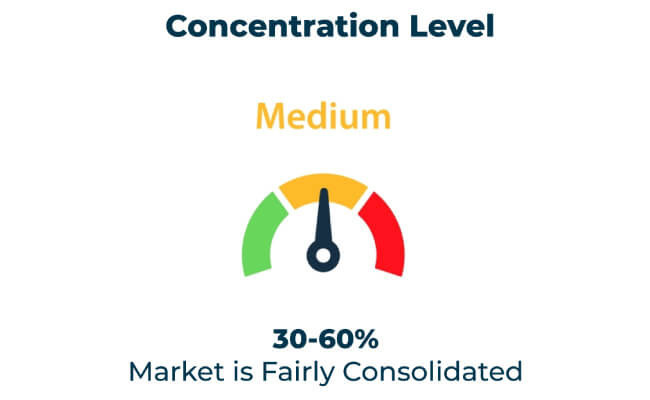The fabric cutting machine market is growing significantly as industries demand efficient, precise, and sustainable solutions for the fabric cutting process. These machines, which are used in the textile, automotive, and apparel sectors, allow for highquality and costeffective production. By 2035, the global fabric cutting machine market is expected to grow to more than USD 670.8 million at a compound annual growth rate (CAGR) of 4.1%.
Companies are working on advanced automation, customization, and ecofriendly technologies to cater to the changing industry demands. With automation and sustainability as the main concerns, fabric cutting machines are playing a vital role in making production easier and reducing material waste.
| Attribute | Details |
|---|---|
| Projected Value by 2035 | USD 670.8 Million |
| CAGR during the period 2025 to 2035 | 4.1% |
Explore FMI!
Book a free demo
Summary
The SWOT analysis summaries the strengths and tactics of market leaders in the fabric cutting machine. Some of the major companies include Gerber Technology, Lectra, and Eastman Machine Company. These companies have gained growth through innovations, quality, and global distribution. Challenges or raw material costs, competition from emerging players, are opportunities to diversify and gain technology advancement.
Gerber Technology
Gerber Technology is strong in the field of automated and precise fabric cutting machines. Innovation and customercentric solutions are at the heart of its market leadership. However, the high initial cost may be a challenge. Expansion into emerging markets with costefficient models offers tremendous growth opportunities.
Lectra
Lectra is a leader in digital and sustainable fabric cutting solutions. Its high technologies and international presence give a competitive edge. Growth is limited by minimal penetration in small markets, although investment in tailormade solutions for niche applications holds a lot of potential.
Eastman Machine Company
Eastman Machine Company is famous for its tough and rugged fabric cutting machines. Strengths are advanced R&D capabilities and customer loyalty. High operational costs remain a challenge, but growing demand for automated solutions offers substantial opportunities.
| Category | Market Share (%) |
|---|---|
| Top 3 Players | 18% |
| Rest of Top 5 Players | 07% |
| Next 10 Players | 13% |
Type of Player & Industry Share
| Type of Player | Market Share (%) |
|---|---|
| Top 10 Players | 38% |
| Next 20 Players | 26% |
| Remaining Players | 36% |

Year to Year Leaders
Opportunities abound in Africa, Southeast Asia, and Latin America. The need for high technology fabric cutting machines is fueled by growing textile industries, urbanization, and sustainability consciousness. Exporters that comply with local regulations and offer competitive solutions can establish a good position.
InHouse vs. Outsourced Manufacturing
The fabric cutting machine market depicts mixed regional trends fueled by industrial growth, automation, and sustainability concerns. As producers align with the regional goals, they can optimize growth opportunities.
| Region | North America |
|---|---|
| Market Share (%) | 35% |
| Key Drivers | Focus on automation and energy efficiency. |
| Region | Europe |
|---|---|
| Market Share (%) | 30% |
| Key Drivers | Leadership in sustainable manufacturing. |
| Region | Asia-Pacific |
|---|---|
| Market Share (%) | 25% |
| Key Drivers | Rapid textile production and industrial growth. |
| Region | Other Regions |
|---|---|
| Market Share (%) | 10% |
| Key Drivers | Expansion in emerging markets. |
The fabric cutting machine market will grow with advancements in digital and automated technologies, sustainable production methods, and global market penetration. Companies that invest in innovation and ecofriendly solutions will dominate the industry.
| Tier | Key Companies |
|---|---|
| Tier 1 | Gerber Technology, Lectra, Eastman Machine Company |
| Tier 2 | Zund Systemtechnik AG, Bullmer |
| Tier 3 | Tukatech, Juki Corporation |
The fabric cutting machine market is poised for sustained growth as industries and consumers prioritize automation, precision, and sustainability. Companies focusing on advanced technologies, ecofriendly designs, and global expansion will shape the future of this dynamic market. Collaboration with textile, automotive, and apparel sectors will unlock further opportunities for growth.
Key Definitions
Methodology
This report combines primary research, secondary data, and expert opinions. The findings are verified through interviews with industry experts and end-users to ensure accuracy and reliability.
The fabric cutting machine market includes the manufacturing and usage of automated and manual machines for cutting fabrics in any industry. The market focuses on accuracy, innovation, and sustainability.
Rising demand for automation, precision, and sustainable production solutions drives growth.
The global fabric cutting machine market is expected to grow to more than USD 670.8 million at a compound annual growth rate (CAGR) of 4.1%.
Gerber Technology, Lectra, and Eastman Machine Company are key players.
High initial costs, market awareness, and regulatory compliance are key challenges.
Opportunities lie in digital and automated systems, eco-friendly solutions, and expanding into emerging markets.
Waterproof Packaging Market Trends - Demand & Industry Forecast 2025 to 2035
Thermochromic Labels Market Insights - Innovations & Growth 2025 to 2035
Utility Cases Market Insights - Growth & Demand 2025 to 2035
Topical Drugs Packaging Market Growth & Forecast 2025 to 2035
Ventilated FIBC Market Growth - Demand & Forecast 2025 to 2035
Telescopic Tool Boxes Market Growth - Demand & Forecast 2025 to 2035

Thank you!
You will receive an email from our Business Development Manager. Please be sure to check your SPAM/JUNK folder too.